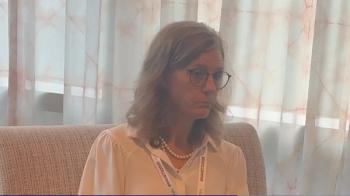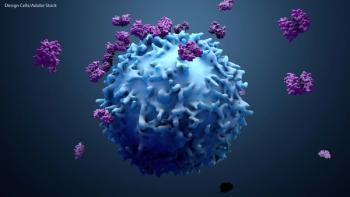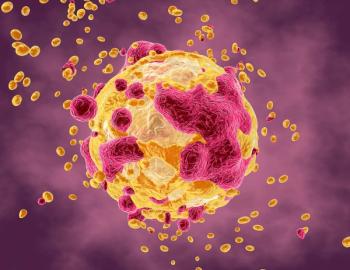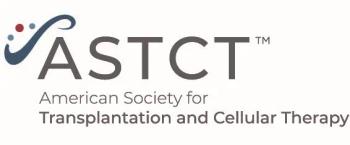
- ONCOLOGY Vol 11 No 9
- Volume 11
- Issue 9
UFT in Gastric Cancer: Current Status and Future Developments
Despite recent progress in surgery and chemotherapy, advanced gastric cancer carries a poor prognosis. Although several antitumor agents have some clinical activity, responses are usually of short duration and fail to
ABSTRACT: Despite recent progress in surgery and chemotherapy, advanced gastric cancer carries a poor prognosis. Although several antitumor agents have some clinical activity, responses are usually of short duration and fail to improve survival. Combination chemotherapy regimens containing fluorouracil (5-FU) and cisplatin (Platinol) frequently result in higher response rates, but fail to significantly alter the ultimate course of the disease. Tegafur and uracil (UFT) have been extensively studied in gastric cancer in Japan. In responding patients, single-agent therapy results in a 1-year survival of 47%. Studies using combination regimens with UFT are currently performed in Europe, and data from Japan demonstrate that UFT can be safely combined with a variety of other agents. However, the exact contribution of UFT in these combinations will need to be evaluated further. The present review summarizes the use of UFT alone or in combination, as well as in the neoadjuvant and adjuvant settings, in the treatment of patients with advanced gastric cancer.[ONCOLOGY 11(Suppl 10):113-118, 1997]
Although the incidence of gastric cancer has been gradually declining in the United States and Western Europe, the disease remains among the most common tumor types and has a dismal prognosis in the advanced stage. Four out of five patients who undergo extensive surgery with curative intent ultimately relapse locoregionally or develop systemic metastases, and the 5-year survival for patients with advanced gastric cancer is still only 5% to 15%.[1,2]
Several antitumor compounds have clinical activity in gastric cancer. Among the most active are fluorouracil (5-FU), mitomycin (Mutamycin), doxorubicin (Adriamycin), and cisplatin (Platinol), all with objective response rates of more than 20%. Somewhat less effective but still active are methotrexate and etoposide (VePesid).[3-7] However, given that responses following single-agent therapy are usually short-lived and complete responses are rare, a variety of combination-chemotherapy regimens have been clinically evaluated. Most of these combinations contain 5-FU (Table 1). Although initial phase II studies in highly selected patients yielded encouraging response rates of up to 60%, with more than 10% complete responses, survival has remained largely unchanged at only 6 to 10 months.
At present, only a small number of randomized prospective studies of combination regimens have been completed. When compared with either fluorouracil/Adriamycin/mitomycin (FAM) or FAM/carmustine, single-agent 5-FU was as effective with regard to response rate and survival, but it was less toxic.[8,9] Similarly, phase III trials comparing combination-chemotherapy regimens have failed to demonstrate a clear survival advantage for any specific regimen.[10-12] However, some regimens were accompanied by severe toxicityspecifically, myelosuppressionand an unacceptably high percentage of toxic deaths.[10-16]
The lack of effective and tolerable treatment options for patients with advanced gastric cancer represents a pressing need for development of new treatment strategies. This review summarizes the clinical experience with tegafur and uracil (UFT) in the treatment of gastric cancer and outlines perspectives for the future development of this compound.
Most early clinical studies of single-agent UFT were conducted by Japanese investigators, and several forms have been evaluated. In an early phase II study of UFT in the treatment of various tumor types, Kikuchi and Wakui[17] observed partial responses in 2 patients with advanced gastric cancer. Malik et al[18] reported 1 partial response among 16 patients treated with UFT and concluded that UFT is convenient for patients and should be considered a therapeutic option in the palliative setting.[18] A summary of survival and response data for single-agent UFT from Japanese studies is provided in Table 2.
Clinical studies with UFT-containing combination regimens, both in neoadjuvant and palliative settings, have been conducted mostly by investigators in Japan. Most combination regimens, including UFT, also contain mitomycin and cisplatin, with or without doxorubicin. Further, in the large majority of studies, the specific contribution of UFT to the overall efficacy of the trial regimen remains unclear, as many studies comprise either small numbers of patients or are case reports indicative of clinical activity. Representative results of larger studies are summarized in Table 3.
Sawa et al[19] treated 42 patients with inoperable gastric cancer, using the Platinol/mitomycin/UFT/etoposide (PMUE) regimen, and reported partial responses in 54%.
In a series of patients with mixed gastrointestinal tumors, Koda et al[20] studied combinations of UFT/doxorubicin and UFT/doxorubicin/cisplatin, with UFT administered at a daily divided dose of 600 mg. For the UFT/doxorubicin combination, 19 patients (8 with advanced gastric cancer) were evaluated and 7 partial responses were noted (5 [63%] in gastric cancer). Of 15 evaluable patients in the UFT/doxorubicin/cisplatin group, 3 of 7 patients with gastric cancers (43%) had a partial response.
Sakata et al[21] used a combination of mitomycin and UFT and reported 3 partial responses out of 17 patients treated. In contrast, none of 8 patients treated with combination UFT/doxorubicin had an objective response.
Iwazaki et al[22] evaluated the combination of cisplatin/mitomycin/UFT in 17 patients and observed a partial response in 4 patients (24%).
Hayakawa et al[23] combined UFT with the etoposide/doxorubicin/cisplatin regimen and reported a response of 47% (16 patients) in 34 patients treated, but the median survival time for their patients was only 10 months. The authors reported that patients with moderately or well-differentiated adenocarcinoma had a higher likelihood of response than patients with poorly differentiated adenocarcinoma (68% vs 20%).
Shinoda et al[24] compared cisplatin/UFT with cisplatin/UFT/etoposide in a randomized trial with 41 evaluable patients, reporting an objective response rate of 52.4% (11 of 21 patients) in the cisplatin/UFT group. The addition of etoposide, however, failed to improve their objective response rate.
In a clinical phase II trial of combination UFT/cisplatin, Sato et al[25] reported an objective response rate of 43% (6 of 14 evaluable patients). Due to the small sample size of this study population, the confidence interval is quite large, but the trial does provide further evidence that the combination of UFT and cisplatin has clinical activity in advanced gastric cancer. Sato et al recently embarked on a phase II study in which cisplatin 80 mg/m2 will be administered intravenously (IV) on day 8, with UFT 360 mg/m2 in a divided dose administered orally on days 1 to 21. Cycles will be repeated every 4 weeks. No data are yet available from this study.
Recent evidence indicates that inhibition of thymidylate synthase in gastrectomy specimens is enhanced if UFT and leucovorin are combined for administration prior to surgery,[26] but, overall, available information about the combination is limited (Table 4).
In one clinical phase II trial, Kim et al[27] used UFT (480 mg/m2/d in a divided dose) in conjunction with leucovorin (25 mg/m2/d) as palliative therapy for advanced gastric cancer. Among 14 evaluable patients, 1 patient achieved a complete response and 3 patients had partial responses. The median duration of survival for all patients was 25 weeks, with 18% of patients surviving after 1 year. The main toxicities observed were diarrhea and oral mucositis.
The European Organization for Research and Treatment of Cancer/Early Clinical Studies Group also has recently activated a phase II study with UFT/leucovorin. UFT will be administered at a dose of 300 mg/m2/day for 28 days, with leucovorin 90 mg/day. Both agents will be given in 3 divided daily doses, and therapy will be followed by a 7-day rest period.
In an attempt to develop an oral regimen for treatment of advanced gastric cancer, Feliu et al[28] combined UFT, leucovorin, and etoposide. To increase the tetrahydrofolate pools, an initial dose of leucovorin 500 mg/m2 was given as an IV bolus administration. Of the 46 patients included, 4 (9%) developed a complete response and 12 (26%) developed a partial response, yielding an overall objective response rate of 35% (95% confidence interval, 22% to 51%). The median duration of response was 10 months, and the median overall survival was 9 months. One patient died from neutropenic sepsis. The authors concluded that this oral regimen is well tolerated and convenient.
In their most recent study, these same investigators replaced etoposide with epirubicin (75 mg/m2), administered intravenously on day 1. Based on pharmacologic considerations, the use of a leucovorin loading dose may be important, but the practice has not been used by other investigators, and its clinical efficacy will need further evaluation.
Only two randomized phase III studies of UFT-containing chemotherapy regimens have been published (Table 5). Although results indicate that UFT-based regimens are at least as active as non-UFT regimens, the statistical power of these studies suffers from small sample size. Thus, definitive conclusions as to the superiority of UFT-based regimens are not yet possible.
Sasagawa et al[29] have conducted a randomized study comparing mitomycin/5-FU and mitomycin/UFT in patients with advanced gastric cancer. Although 3 of 13 (23%) evaluable patients responded to the UFT-containing regimen, only 1 of 15 patients (6.7%). showed a partial response in the 5-FU-containing regimen. In addition, the authors reported that quality of life was higher in the UFT group.
Kurihara et al[30,31] performed a randomized study comparing mitomycin/tegafur with mitomycin/UFT in patients with advanced gastric cancer and reported a statistically significant increase in response rate and survival for the mitomycin/UFT group.
In a pilot study of patients with hepatic metastases, Yonemura et al[32] used a combination of regional infusional mitomycin and cisplatin and oral UFT. They reported local partial responses in 9 out of 12 evaluable patients. However, the relative importance of the individual components of this treatment is unclear, as is any contribution of UFT to the gastrointestinal and bone marrow toxicity observed.
UFT-Containing Regimens as Neoadjuvant Treatment
In a pilot trial of PMUE in 8 patients with inoperable gastric cancer, Kato et al[33] administered between 1 and 5 courses of PMUE as an intra-arterial, intravenous, or intraperitoneal infusion, achieving partial responses in seven patients (88%). Subsequent surgery performed on 5 patients showed no tumor in 2 and residual tumor in 3 patients. Subsequent to surgery, PMUE was continued as adjuvant therapy in the 5 patients, but no definitive conclusions can be drawn from this study, except that PMUE appears to be a highly active regimen.
In a randomized comparative trial, Yonemura et al[34] compared neoadjuvant and adjuvant administration of PMUE in patients with stage IV gastric cancer and measurable lesions. In this study, 29 patients received PMUE as neoadjuvant therapy followed by surgery, whereas 26 patients underwent primary surgery followed by adjuvant chemotherapy. The authors reported a higher response rate (62% vs 35%). and improved survival in the neoadjuvant group. While this study demonstrates that PMUE is an active regimen and indicates that neoadjuvant chemotherapy may be important in improving the outcome for patients with unresectable gastric cancer, the specific contribution of UFT remains unclear.
In an attempt to correlate clinical antitumor effects with the extent of thymidylate synthase inhibition, Tanaka et al[35] administered cisplatin combined with UFT to 24 patients prior to surgery. In this study, a correlation was found between thymidylate synthetase inhibition and antitumor effect. Although these data are in agreement with preclinical results, larger studies are required to define the value of thymidylate inhibition for monitoring therapy.
UFT Containing Regimens as Adjuvant Treatment
Japanese investigators also have integrated UFT into adjuvant treatment strategies following complete surgical resection of gastric cancer. Arima et al[36] reported a randomized study involving 210 evaluable patients with ³ stage II gastric cancer. In stage IV patients, treatment with mitomycin (20 mg on the day of surgery, 10 mg day 1 post-surgery, and then 10 mg every 3 months) was compared with mitomycin plus UFT (600 mg daily in a divided dose). The authors found a statistically significant increase in 5-year survival for the patient cohort receiving UFT. In addition, patients with poorly differentiated adenocarcinoma had a prolonged survival when treated with UFT.
Because UFT is an oral medication and patients with gastric cancer often must undergo extensive bowel surgery, the issue of drug bioavailability is of potential importance. Addressing this issue, Suda et al[37] have measured serum concentrations of UFT, 5-FU, and uracil and have correlated the results with the type of surgery performed. As would be expected, a rather rapid increase in serum UFT concentrations was seen in patients following total gastrectomy. In contrast, emptying of the gastric contents was delayed in patients with a Billroth I resection, and, consequently, the rise in serum concentrations of UFT, 5-FU, and uracil also were delayed.
Maehara et al[38] conducted a comparative pharmacokinetic study in patients with early-stage disease patients before and after various surgical procedures. It was determined that the area under the concentration-time curves of 5-FU and uracil, but not of tegafur, decline temporarily after surgery. Only 3 months after surgery, however, serum concentrations of 5-FU and uracil had returned to preoperative values. The authors concluded that dose adjustments might be necessary in the immediate postoperative period for patients treated with UFT. Although differences in resorption certainly may affect antitumor activity and the pattern of toxicity, large clinical studies have not yet incorporated stratification of surgical procedures.
The issue of patient compliance also must be addressed if oral antitumor agents are administered. A report by Ohsawa et al[39] indicates that in patients treated with UFT, patient compliance may be monitored via determination of urine concentrations of 5-FU and tegafur, though not of uracil. Alternatively, serum concentrations of tegafur and 5-FU also may be used to monitor patient compliance[40].
UFT has been shown to be a safe and well-tolerated compound in the treatment of gastric cancer, as well as several other tumor types with potential sensitivity to 5-FU. However, the optimal dose and treatment duration have not yet been clearly identified. In addition, a number of other issues deserve continuing clinical evaluation. First, the optimal means of combining UFT with other agents needs to be characterized. Second, the value of UFT-containing combinations in the neoadjuvant setting warrants further research. At present, the specific contribution of UFT to clinical activity is unclear. Third, available evidence suggests that UFT might have a place in adjuvant chemotherapy for locally advanced gastric cancer, but further trials are necessary to unequivocally demonstrate the actual value of the agent in this situation. Finally, it will be necessary to demonstrate that combination UFT/leucovorin is clinically equivalent to combination 5-FU/leucovorin. Studies to address these questions are currently under way.
References:
1. Boring C, Squires T, Tong J: Cancer statistics. CA Cancer J Clin 41:28-29, 1991.
2. Mettlin C: Epidemiologic studies in gastric adenocarcinoma, in Douglass HO Jr (ed): Gastric Cancer pp 1-25. New York, Churchill Livingstone, 1988.
3. Cocconi G, De Lisi V, Di Blasio B: Randomized comparison of 5-FU alone or combined with mitomycin and cytarabine (MFC) in the treatment of advanced gastric cancer. Cancer Treat Rep 66:1263-1266, 1982.
4. Cullinan SA, Moertel CG, Fleming TR, et al: A comparison of three chemotherapeutic regimens in the treatment of advanced pancreatic and gastric carcinoma. JAMA 253:2061-2067, 1985.
5. Moertel CG, Lavin PT: Phase II-III chemotherapy studies in advanced gastric cancer. Cancer Treat Rep 63:1863-1869, 1979.
6. Lacave AJ, Wils J, Diaz-Rubio E, et al: cis-Platinum as second-line chemotherapy in advanced gastric adenocarcinoma. Am J Clin Oncol 6:35-38, 1983.
7. Leichman L, McDonald B, Dindorgu A, et al: Cisplatin: An active drug in the treatment of disseminated gastric cancer. Cancer 53:18-22, 1984.
8. De Lisi V, Cocconi G, Tonato M, et al: Randomized comparison of 5-FU alone or combined with carmustine, doxorubicin and mitomycin (BAFMi) in the treatment of advanced gastric cancer. A phase III trial of the Italian Clinical Research Oncology Group (GOIRC). Cancer Treat Rep 70:481-485, 1986.
9. Beretta G, Anoldi E, Beretta GD, et al: Fluorouracil versus FAM polychemotherapy in gastric cancer. A randomized study. Proc Eur Conf Clin Oncol 1989.
10. Kelsen D, Atiqt O, Saltz L, et al: FAMTX (fluorouracil, methotrexate, Adriamycin) is as effective and less toxic than EAP (etoposide, Adriamycin, cisplatin): A random assignment trial in gastric cancer (abstract). Proc Am Soc Clin Oncol 10:37, 1991.
11. Wils JA, Kleint HO, Wagener DJT, et al: Sequential high dose methotrexate and fluorouracil combined with doxorubicina step ahead in the treatment of advanced gastric cancer: A trial of the European Organization for Research and Treatment of Cancer Gastrointestinal Tract Cooperative Group. J Clin Oncol 9:827-831, 1991.
12. Webb A, Cunningham D, Scarffe JH, et al: A randomized trial comparing ECF with FAMTX in advanced oesophago-gastric cancer (abstract). Proc Am Soc Clin Oncol 15:465, 1995.
13. Preusser P, Wilke H, Achterath W, et al: Phase II study with the combination etoposide, doxorubicin, and cisplatin in advanced measurable gastric cancer. J Clin Oncol 7:1310-1317, 1989.
14. Katz A, Gansl R, Simon S, et al: Phase II trial of VP-16, Adriamycin, and cis-Platinum in patients with advanced gastric cancer (abstract). Proc Am Soc Clin Oncol 8:98, 1989.
15. Taguchi T: Combination chemotherapy with etoposide, Adriamycin and cisplatin (EAP) for advanced gastric cancer (abstract)) Proc Am Soc Clin Oncol 8:108, 1989.
16. Klein HO: Long term results with FAMTX (5-fluorouracil, Adriamycin, methotrexate) in advanced gastric cancer. Cancer Res 9:1025-1026, 1989.
17. Kikuchi KS, Wakui A: Cooperative research of UFT E phase II study. Cooperative Study Group of UFT E in Tohoku Area. Gan To Kagaku Ryoho 17:2183-2190, 1990.
18. Malik ST, Talbot D, Clarke PI, et al: Phase II trial of UFT in advanced colorectal and gastric cancer. Br J Cancer 62:1023-1025, 1990.
19. Sawa T, Kinoshita K, Takekawa S, et al: Effect of PMUE therapy (CDDP, MMC, UFT, etoposide) in terminal gastric cancer. Gan To Kagaku Ryoho 17:2381-2386, 1990.
20. Koda K, Nakazawa O, Morita K, et al: Combination chemotherapy of UFT with Adriamycin (ADM) and cisplatin (CDDP) for advanced gastrointestinal cancer. Gan To Kagaku Ryoho 17:1893-1900, 1990.
21. Sakata Y, Chiba Y, Sato T, et al: Comparative study of UFT plus mitomycin C and UFT plus doxorubicin in adenocarcinoma. Hirosaki Cooperative Group of Cancer Chemotherapy. Gan To Kagaku Ryoho 19:195-201, 1992.
22. Iwazaki R, Yasutake K, Fukuyama Y, et al: UFTPM (UFT + CDDP + MMC) therapy for progressive stomach cancer. Research Association of Progressive Stomach Cancer. Gan To Kagaku Ryoho 20:1179-1185, 1993.
23. Hayakawa M, Morise K, Chin K, et al: Combination chemotherapy with tegafur*uracil (UFT), etoposide, Adriamycin and cis-Platinum (UFT-EAP) for advanced gastric cancer. Jpn J Clin Oncol 24:282-288, 1994.
24. Shinoda M, Morise K, Kusugami K, et al: Combination chemotherapy with FP versus FEP in patients with advanced gastric cancer. Research Group of Gastric Cancer Chemotherapy. Gan To Kagaku Ryoho 22:515-520, 1995.
25. Sato A, Hasegawa K, Kurihara M, et al: Combination chemotherapy with tegafur-uracil (UFT) and cisplatin (CDDP) for advanced gastric cancer. UFTP Study Group. Gan To Kagaku Ryoho 22:1355-1362, 1995.
26. Ichikura T, Tomimatsu S, Okusa Y, et al: Thymidylate synthase inhibition by an oral regimen consisting of tegafur-uracil (UFT) and low dose leucovorin for patients with gastric cancer. Cancer Chemotherapy Pharmacol 38:401-405, 1996.
27. Kim YH, Cheong SK, Lee JD, et al: Phase II trial of oral UFT and leucovorin in advanced gastric carcinoma. Am J Clin Oncol 19:212-216, 1996.
28. Feliu J, Gonzalez-Baron M, Garcia-Giron, C, et al: Treatment of patients with advanced gastric carcinoma with the combination of etoposide plus oral tegafur modulated by uracil and leucovorin. A phase II study of the ONCOPAZ Cooperative Group. Cancer 78:211-216, 1996.
29. Sasagawa T, Hoy N, Endo T, et al: Randomized controlled trial of MMC + UFT and MMC + 5-FU therapy in advanced gastric cancer. Gan To Kagaku Ryoho 21:1179-1185, 1994.
30. Kurihara M, Izumi T, Yoshida S, et al: A cooperative randomized study on tegafur plus mitomycin C versus combined tegafur and uracil plus mitomycin C in the treatment of advanced gastric cancer. Jpn J Cancer Res 82:613-620, 1991.
31. Kiyohashi A, Kurihara M, Yoshida S, et al: Antitumor effect and survival benefit of chemotherapy for unresectable advanced gastric cancer. Jpn J Clin Oncol 23:41-45, 1993.
32. Yonemura Y, Fujimura T, Urade M, et al: Clinical experiences with hyperthermochemotherapy of hepatic metastasis from gastric cancer. Gan To Kagaku Ryoho 18:625-629, 1991.
33. Kato M, Kinoshita K, Sawa T, et al: Neoadjuvant chemotherapy of far advanced gastric cancereffect of preoperative chemotherapy by PMUE (CDDP, MMC, UFT, etoposide). Gan To Kagaku Ryoho 17:391-396, 1990.
34. Yonemura Y, Sawa T, Kinoshita K, et al: Neoadjuvant chemotherapy for high-grade advanced gastric cancer. World J Surg 17:256-261, 1993.
35. Tanaka S, Umeno T, Mitsuishi K, et al: UFT/CDDP preoperative chemotherapy for progressive gastric cancerhistological antitumor effects and thymidylate synthase inhibition rate. Gan To Kagaku Ryoho 22:1947-1951, 1995.
36. Arima S, Yamamoto H, Hisatsugu T et al: Multihospital cooperative study of post-operative adjuvant chemotherapy in the treatment of gastric cancer (Part 3). Comparisons between tegafur and UFT. North Kyushu Cooperative Study Group for Cancer Chemotherapy. Gan To Kagaku Ryoho 18:443-449, 1991.
37. Suda Y, Uchida K, Okamura H, et al: Blood concentrations of futraful, uracil and 5-fluorouracil (5-FU) after UFT administration in the various reconstructions after gastrectomy. Saitama UFT Research Group. Gan To Kagaku Ryoho 19:2181-2187, l992.
38. Maehara Y, Takeuchi H, Oshiro T, et al: Effect of gastrectomy on the pharmacokinetics of tegafur, uracil, and 5-fluorouracil after oral administration of a 1:4 tegafur and uracil combination. Cancer Chemother Pharmacol 33:445-449, 1994.
39. Ohsawa S, Kondo Y, Shiroto H, et al: A study of urinary tegafur, 5-fluorouracil (5-FU) and uracil concentrations in the cases of gastric carcinoma for the confirmation of drug-taking compliance after UFT oral administration, Gan To Kagaku Ryoho 19:2189-2193, 1992.
40. Watanabe H, Sakakibara N: Evaluation of long-term administration of oral anti-cancer agent. Gan To Kagaku Ryoho 20:637-642, 1993.
Articles in this issue
about 28 years ago
UFT: East Meets West in Drug Developmentabout 28 years ago
Rationale for Phase I Study of UFT Plus Leucovorin and Oral JM-216about 28 years ago
Postoperative Adjuvant Chemotherapy for Non-Small-Cell Lung Cancerabout 28 years ago
Oral UFT and Leucovorin in Patients With Advanced Gastric Carcinomaabout 28 years ago
Experience With UFT in JapanNewsletter
Stay up to date on recent advances in the multidisciplinary approach to cancer.



















































































